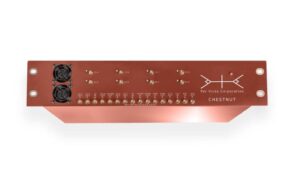 Per Vices Corporation has released Chestnut, a new high-performance SDR (software-defined radio) designed for a variety of wireless applications such as UAV (unmanned aerial vehicle) communications and signals intelligence (SIGINT).
Per Vices Corporation has released Chestnut, a new high-performance SDR (software-defined radio) designed for a variety of wireless applications such as UAV (unmanned aerial vehicle) communications and signals intelligence (SIGINT).
Chestnut provides a four-receive and four-transmit radio chain architecture, with each radio chain being independently controlled while maintaining phase coherency for applications requiring this functionality. Each radio chain also offers 500 MHz of RF bandwidth, resulting in 2 GHz of RF bandwidth capture when all chains are enabled. The tuning range of near DC to 9 GHz also allows for these radio chains to be used for applications that require wide operating frequencies.
Chestnut is powered by an Intel FPGA SoC (system-on-chip), and includes separate interfaces for management and data. The management interface includes dual 1G ports that allow for full redundancy, while the two qSFP+ ports offer 100Gbps of data transfer per port with the SDR able to support up to 200Gbps transfers in total. The internal, high stability, oven-controlled crystal oscillator (OCXO) provides the flexibility of being able to accept an external 10 MHz source or using the onboard OCXO to synchronize multiple devices.
The device features a 19″ 2U compact form factor, native web interface, and UHD compatibility out of the box. Users can prototype and test difference communications, use the platform for spectrum monitoring, recording and playback, phased array applications, and many more.
Brandon Malatest, COO of Per Vices, commented: “We are very excited to be adding Chestnut to our family of high performance SDR products. Chestnut offers customers another option when selecting the best performing SDRs required to meet their requirements while also leveraging our extensive integration experience.”
Find suppliers & manufacturers of Software Defined Radios for unmanned systems >>


















